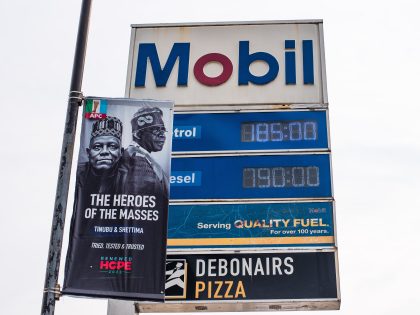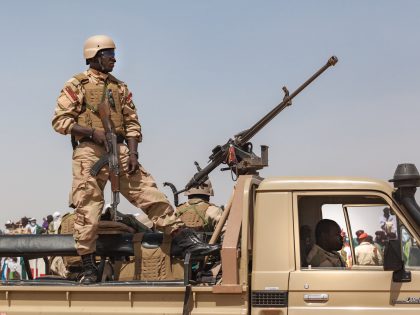How to Paint Ghosts
An interview with Ivorian artist Aboudia. Jean-Michel Basquiat is often cited as an influence in his work, but local experience is a bigger muse.

Via Jack Bell Gallery.
“Artists don’t create reality they make phantasms”, using a kind of “fantastical technique to produce an artificial dream for the waking world”. At least that’s what Plato thought. In the paintings of Aboudia, we cannot be sure if the figures are alive or dead, if the nightmare they inhabit is reality or fabrication. The figures are drawn in the brutal and naive style of a child, but they are not so easily identified: these are not the same photogenic children pictured on adverts for development funds and charities, inviting paternalistic investment, but sketchy, ghostly figures whose mouths are not prettily silent or widely smiling but cancelled out, eyes not vacant but withdrawn, their speech impossible and thoughts illegible, they are unavailable to the viewer, but their unknowability confronts us like a crisis.
Aboudia Abdoulaye Diarrassouba was born in Côte d’Ivoire in 1983, and studied in Bingerville before setting up his studio in Abidjan. He first reached an international audience during the siege of Abidjan in 2011, when the conflict came close to his studio. Two years later, his work has exhibited in Africa, Europe and America, and bought by influential contemporary art collectors including Charles Saatchi, Jean Pigozzi and Frank Cohen. This is no doubt a testament to growing market interests in under-developed regions of African contemporary art, an unsurprising taste in art’s witness to authentic conflicts, but also to Aboudia’s singular vision and vigorous work ethic, the apparent synthesis of American avant-garde traditions and the graffiti of youths in the communities where he lives.
Jean-Michel Basquiat is often cited as an influence, which may seem an irritating and predictable way to establish the value of a young painter’s work, but here it seems necessary: Aboudia made a recent series of watercolors on pages torn out of a Warhol catalogue. If these American influences appear to be at the foundation of the work, they have been worked over and blotted out with, with playful antagonism towards these American authorities which have serious implications in the paintings’ subject matter: the occupation of Abidjan by UN peacekeepers. The question of influence reflects a social contradiction at the heart of Aboudia’s work, the productiveness of these foreign influences, and the work’s persistent naivity, locating its primary significance in local experience.
Aboudia’s London gallerist, Jack Bell describes Aboudia’s first trip to London, for the opening of his exhibition in 2011: “We checked out the Tate Modern where we looked at huge canvases by Jackson Pollock and Cy Twombly – Aboudia was impressed by the mural scale and the loose style. Aboudia picked up a lot of books on traditional African art. He was absolutely blown away by the warehouse scale art supply shops in Shoreditch and went bananas.”
His work – pictured here – was recently exhibited in his second solo show at Jack Bell’s gallery, and it exhibits a continuation of the same interest in social inequality but Aboudia’s style has developed. In the newer work figures are drawn over other figures, whose partly-obscured faces persist in a state of permanent surprise, to find themselves partly erased, the canvases full of noise and colour, the business of violence-as-usual.
Bell describes Aboudia’s work most recent work as such: “Imagery and collage been drawn from the Financial Times, traditional African art, pornography and the people that make up Aboudia’s local neighborhoods. Works build up the same multi-media layering to which paint and crayon is then applied.”
Shortly before the end of his second solo show in London we emailed the artist with some questions about his work.
What are your first memories of painting? And who taught you to make art?
I always knew how to draw and when I grew up I went to the Centre Technique des Arts Appliqués de Bingerville to take courses in art and mural-painting.
I saw an image of one of your paintings called “Children Reading”, and I read that you think education is the thing which will most change your country – so how are children, the way they see the world – important to your work?
The place of children in my work is very important, in that it is these children I love the most, who inspire me, and who are at the foundation of what I create. Our vision of the world is positive: of a world without war, without children on the streets, without children orphaned by war, without children mistreated, a world for children who are happy, joyful, educated and in good health.
Your paintings are often drawn or written across the surface of the canvas, rather than creating an appearance of depth – is graffiti important to you?
Yes, graffiti is important for me, for it allows me to express myself through the youth.
Your work often uses collage, pieces of newspaper or magazines – could you tell us something about how you choose these materials? And, do you think the viewer will read the print?
I’ll say that all the paper I use as collage are educational materials, and when we talk about education in this job it’s important to find educational elements in the works we make, not so that the spectator reads it, but at the same time, if the viewer readers it all the better.
Your first exhibition at Jack Bell’s gallery had as its title “Les Fantômes,” and the bodies in your paintings often seem to be transparent, ghostly – are your paintings haunted?
Yes my works are haunted by the memory of all the children, whether they are red yellow black white, by their dreams, ambition etc…
Your work has been received with enthusiasm in England, and elsewhere internationally, but can you tell me about how it is received in the Côte d’Ivoire?
At the beginning my art wasn’t well received but now everyone is talking about my fortune and one thing is clear that I work to make no one happy, that I do what I’ve been doing recently to carry the thoughts and dreams of the children and childhood.
Has traveling outside the Côte d’Ivoire influenced your style of painting?
Yes for sure, but I’ve always tried to maintain the foundations, and tried to do more by adding to that what we see elsewhere, because art is the search for new sensations.
Are there living artists who have influenced you?
I don’t see any living artists who inspire me at the moment, except for the drawings of the youth of Abidjan, Côte d’Ivoire, make on the walls of [communities on the peripheries of Abidjan] Abobo, Yopougon, Threchville…
You often paint on large canvases – does painting on a large scale allow you to present images in a different way? Does it allow you to think about history or politics in a different way?
Large format paintings allow me to think of dreams in the largeness and in the same colours of those youth who roam the streets, painting on the large walls we find all around us.
Now that your work is being exhibited in London and New York, are there aspects which a non-Ivorian viewer will not understand?
I don’t think much aspects of my work will be missed by New Yorkers or Londoners since all courageous people, with large hearts, sensible to the cause of the youth will support us, just by coming to the exhibitions organized by Jack Bell and others. For us, it’s great, it’s enormous.
- Aboudia lives and works in Abidjan, and also part-time in Brooklyn, New York. Future exhibitions include a solo show at Jack Bell Gallery, London, 2014.



















